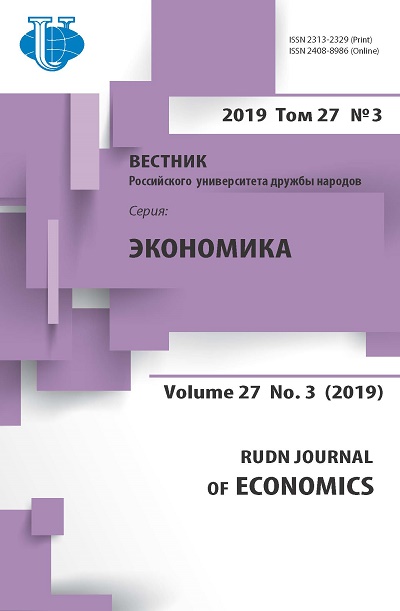Crossborder tourist mobility in borderland: theoretical and practical aspects
- Authors: Stepanova S.V.1
-
Affiliations:
- Karelian Research Center of Russian Academy of Sciences
- Issue: Vol 27, No 3 (2019)
- Pages: 563-575
- Section: Industrial organization markets
- URL: https://journals.rudn.ru/economics/article/view/23119
- DOI: https://doi.org/10.22363/2313-2329-2019-27-3-563-575
Cite item
Full Text
Abstract
The socio-economic transformations of Russia as well as the change in the functions of state borders in the context of integration processes in the global society, along with the change in the perception of the tourism at the level of government, business and society, served as a prerequisite for the tourist vector of development of border areas. The increasing competition for the financial resources of tourists contributes to a change in the socioeconomic space of the territories, which is most noticeable in the borderlands. The article substantiates the importance of cross-border tourist mobility in the development of the borderland. Depending on the chosen focus of attention (development of the local community, economic and spatial development of the territory), the benefits and risks for the socio-economic development of the territory are different for the both sides of the border. The cross-border tourist mobility is considered on the example of the Russian-Polish and Russian-Finnish borderlands. A significant asymmetry of mutual cross-border tourist flows has been revealed. This tendency will increase thanks to the actively pursued marketing policy of the business of neighboring countries to stimulate the entry flow of Russian citizens with tourist purposes.
Keywords
About the authors
Svetlana V. Stepanova
Karelian Research Center of Russian Academy of Sciences
Author for correspondence.
Email: svkorka@mail.ru
Candidate of Economic Sciences, research fellow of the Department of Regional Economic Policy, Institute of Economics
50 A. Nevskogo Ave., Petrozavodsk, 185030, Russian FederationReferences
- Aleksandrova A.Yu. (2017). Geography of tourist flows in the Russian Federation: statistics, trends, challenges. Problems. Science. Innovation Technology, (1), 95–108. (In Russ.)
- Anisiewicz R., Palmowski T. (2014). Small border traffic and cross-border tourism between Poland and the Kaliningrad oblast of the Russian Federation. Quaestiones Geographicae, 33(2), 79–86.
- Bar-Kołelis D., Wiskulski T. (2012) Cross-border shopping at polish borders tri-city and the Russian tourists. GeoJournal of Tourism and Geosites, 9(1), 43–51.
- Björn I. (2015). Border province: the main features of the development of North Karelia after World War II. Studia Humanitatis Borealis, 2(5), 4–16. (In Russ.)
- Bolychev O.N., Gumenyuk I.S., Kuznetsova T.Yu. (2015). Local border traffic and the deve- lopment of retail trade in the Kaliningrad region and Polish borderlands. Baltic region, 4(26), 102–112. (In Russ.)
- Transgranichnaya mobil'nost' v regione OBSE. Analiz sushchestvuyushchei situatsii [Crossborder mobility in the OSCE region. Analysis of the existing situation] (p. 163). (2014). Warsaw: Agencja Karo. (In Russ.)
- Gumenyuk I., Kuznetsova T., Osmolovskaya L. (2016). Local border traffic as an efficient tool for developing cross-border cooperation. Baltic region, 80(1), 67–82. (In Russ.)
- Kolosov V.A. (2016). Cross-border regionalization and frontal migration: European experience for Russia? Regional studies, 3(53), 83–93. (In Russ.)
- Kolosov V.A., Zotova M.V., Sebentsov A.V. (2016). Barrier function of Russian borders. Bulletin of the Russian Academy of Sciences. Geographical Series, (5), 8–20. (In Russ.)
- Kolosov V.I., Klemeshev A.P., Zotova M.V., Sebentsov A.V. (2015). Russia-European Union borderlands: transboundary gradients, interactions and current challenges. International Journal of Economics and Financial Issues, (5), 5–12.
- Makkonen T. (2016). Cross-border shopping and tourism destination marketing: the case of Southern Jutland, Denmark. Scandinavian journal of hospitality and tourism, 16(1), 36–50. doi: 10.1080/15022250.2016.1244506.
- Mezhevich N.M., Zhuk N.P. (2013). Cross-border specialization of interregional interaction: applying new assessment methods. Baltic region, 1(15), 38–52. (In Russ.)
- Miroshnichenko O.V., Ponkratova L.A. (2011). International tourist migrations as a factor of integration processes between Russian and Chinese regions. Management of economic systems, (32), 1–42. (In Russ.)
- Pirozhnik I.I. (2015). Tourist migration in cross-border region as a factor of enhancing economic cooperation (exemplified by Belarusians-Polish borderland). Security Issues in Russian Society, (2), 141–150. (In Russ.)
- Shlapeko E.A., Stepanova S.V. (2018). Contemporary challenges for small border cities. RUDN Journal of Economics, 26(3), 495–505. (In Russ.)
- Stepanova S.V. (2014). Tourism infrastructure in border regions of Russia: current status and problems. Baltic region, 2(70), 51–64. (In Russ.)
- Stepanova S.V., Shlapeko E.A. (2018). Trends in the development of cross-border trade in the Russian-Finnish borderlands. Baltic region, 10(4), 103–117. doi: 10.5922/20798555-2018-4-7. (In Russ.)
- Studzinska D., Sivkoz A., Domaniewski S. (2018). Russian cross-border shopping tourists in the Finnish and Polish borderland. Norsk Geografisk Tidsskrift [Norwegian Journal of geography], 72(2), 115–126.
- Tömöri M. (2010). Investigating shopping tourism along the borders of Hungary – a theoretical perspective. GeoJournal of Tourism and Geosites, 6(2), 202–210.
- Tsapenko I.P. (2018). Cross-border population mobility: format update. Bulletin of the Russian Academy of Sciences, 88(11), 992–1002. (In Russ.)
- Więckowski M. (2010). Tourism development in the borderland of Poland. Geographia Polonica, 83(2), 67–81. doi: 10.7163/GPol.2010.2.5.
- Zaitseva N.A., Korneevets V.S., Kropinova E.G., Kuznetsova T.Yu., Semenova L.V. (2016). Effect of cross-border movements and exchanges on the economic diversification of the cross-border cooperation regions (case for the Russian-Polish borderlands). Regional studies, 3(53), 94–101. (In Russ.)















